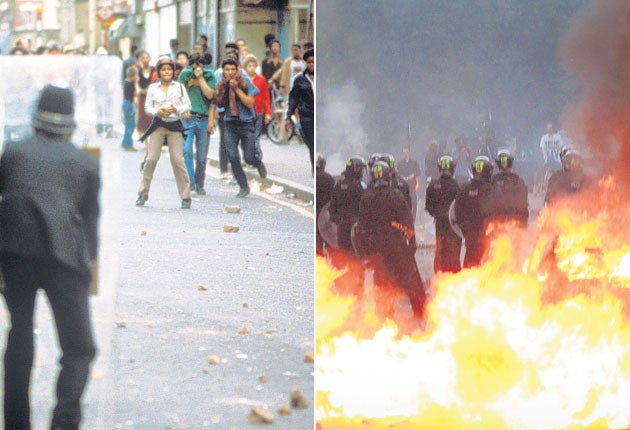Paul Vallely: Shades of 1980s riots, but there have been big changes since then
Comment

The similarities between the rioting in London and the race riots which shocked Britain in the 1980s are striking. But they do not tell the whole story.
The trigger for civil discord has almost always been an action by the police which the black community has regarded as a particularly egregious example of a generally poor relationship between police and a local population.
In Brixton in 1981 trouble was sparked when police stopped a young black man who had been stabbed but who others assumed was a victim of police brutality. In Toxteth, Liverpool, the same year, it was the arrest of a student, Leroy Cooper, who intervened when police tried to detain an innocent man.
In Handsworth, Birmingham, in 1985, another arrest set off two days and nights of looting and arson. That year Brixton erupted again when police shot and paralysed a woman while trying to arrest her son. A month later another mother had a heart attack and died when police raided her home, setting off the Broadwater Farm riots. A peaceful protest outside a police station led to violence.
There is a familiarity, too, to the criticisms that police provoked trouble by heavy-handed tactics. Again critics said they were unprepared for trouble. Again they said that containment tactics, rather than aggressive snatch-squads, allowed rioting to continue longer than necessary. Yet in most cases inquiries later showed that the speed and scale of events had left them little choice, but to corral the worst troublemakers and deploy officers to protect firemen.
Again, most unrest took place against a background of inner-city deprivation, social alienation and high unemployment, particular among young people. In all cases there were recession and spending cuts. And good weather. A rainy night is no good for a riot.
And yet there have been big changes since the 1980s riots. After Brixton the Scarman report was scathing about Metropolitan Police tactics. They had brought about a big fall in street crime, but at the cost of ramping up racial resentment. The riots, Scarman said, were "essentially an outburst of anger and resentment amongst young black people against the police" their hardline methods, lack of consultation and widespread racism.
After Scarman came new rules on stop and search procedures, better training for police and a call for more black officers. An independent Police Complaints Authority was set up. Large amounts of public money was put into urban regeneration. Generally race relations improved, with the Macpherson report intensifying self-scrutiny among the police.
Evidence of progress is clear in the Met's Operation Trident, a dedicated team to tackle the rise in gun attacks, which has broken through the suspicion between blacks and the police. It is sadly ironic therefore, that the weekend's rioting was sparked by an arrest by the Trident team. Perhaps significant progress has not yet eradicated the deep-seated resentment of the police among black youths which after Broadwater led the black leader, Bernie Grant, to claim, with a tinge of approval, that the police "got... a bloody good hiding".
Or there may be something self-destructive in black youth culture which, 30 years on from the Toxteth riot, led the man who detonated it, Leroy Cooper, to reflect to the Liverpool Daily Post: "The riot was a symptom of there being something really wrong with our society. We smashed our own community up, we destroyed our own homes. There had to be something wrong."
But there are other differences too. The riots in the 1980s were on a much bigger scale. Several people died, hundreds were injured and the damage bill ran into billions at today's prices. There was more planning too; the weekend's riots were orchestrated impromptu on Twitter, but in the 1980s serious preparation went into assembling barricade materials and manufacturing large numbers of petrol bombs.
There is something else. Today's riots have been characterised by opportunist looting on a scale which befits our era of wanton materialist consumerism. Looters have been seen trying things on for size or browsing through vitamin supplements in smashed up shops to find the particular brand they crave.
This is rioting-meets-shopping. It does not, as one eye-witness put it, feel like an "appeal from the heart of the ghetto" so much as an opportunity "to get a nice new pair of trainers." Not so much desperate as decadent.